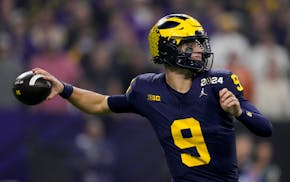The setting reeked of optimism. The sun baked us as we stood by the bullpen in Fort Myers, watching Jose Berrios throw fastballs. Behind us, Byron Buxton shagged flies with grace rarely seen even in big-league camps.
The future was bright as the glint of spikes in the Florida sun, and then Kent Hrbek leaned over and said, "Yeah, I know they're good prospects. But it's hard to depend on prospects.''
The words were simple and true. After years of celebrating the promise of Buxton, Berrios, Alex Meyer and Miguel Sano, the Twins lost their first nine games of the 2016 season, destroyed hope as well as their ability to compete and prompted a season of dramatic organizational change.
Now the Timberwolves, with talent even more precocious and accomplished than the Twins', have started the season 3-7, looking more like an AAU team than one coached by a renowned defensive guru. Target Center is closer to empty than full, and the Twin Cities are being reminded again that there is a downside to promise and promotion.
If the kids aren't ready to win, their organization looks hopeless and perhaps even desperate, and anyone who has expressed optimism — from team ownership to local writers — looks at least temporarily foolish.
All markets experience this and most franchises go through it at some point, but there is no denying that the Twin Cities have become a bastion of broken promise.
The Timberwolves have four youngsters who could become superstars, in Karl-Anthony Towns, Andrew Wiggins, Zach LaVine and Kris Dunn, yet they are losing to less-talented teams.
The Twins have two players built for stardom in Buxton and Miguel Sano, and another dozen prospects who could fuel a winning team, yet their franchise has lost credibility by producing five horrendous seasons since 2010.
The Vikings surged to a 5-0 record this season with a defense featuring young and youngish players, but the defense has backslid from dominant to competent.
The Wild has been waiting for years for their young players to elevate the franchise, but it lacks blue chips and pure scorers, leaving General Manager Chuck Fletcher seeking coaches who can win with a system rather than skill.
The metro's most successful team, the Lynx, combined high draft choices, trades and free agency to build a powerhouse, but that required being bad enough to land Seimone Augustus and Maya Moore as No. 1 picks.
What feels most frustrating about the failures of so many promising young players across so many sports is that these teams' plans should work. At the very least, the plans are rational and defensible.
The Twins of the 1980s brought up a host of quality young players but had to lose a lot of games and choke away a pennant race before they won two World Series.
The Twins of the 1990s weren't just terrible, they suffered because of the failures of so many of their top prospects. David McCarty, the third pick in the draft, failed. A prominent Minnesota columnist wrote that when the Twins lost high draft choice Travis Lee on a technicality, the franchise was doomed. And there is the vivid case of David Ortiz's release.
Despite those three developments, the Twins were winners for much of the 2000s because of a wave of less-celebrated kids.
The best way to build a winner in professional sports is with quality young players. Local teams don't have the wrong blueprint; they merely have to worry whether they have the right blue chips.
Every NBA franchise save the Warriors and Cavaliers would kill for the Wolves' talent. Every baseball franchise would want Buxton and Sano. Every NFL franchise would want the Vikings' best defenders. Of the four most prominent Minnesota pro sports teams, only the Wild lacks the kind of young player destined to become a franchise-changing star.
Here's the thing about teams asking for patience: They're right about that. But they can't sell it.
Jim Souhan's podcast can be heard at MalePatternPodcasts.com. On
Twitter: @SouhanStrib. • jsouhan@startribune.com

Souhan: Now that's a playoff atmosphere, Minnesota!

Souhan: Should Vikings even consider McCarthy in NFL draft?

Souhan: NAW erases Suns' lead, Game 1 advantage with big performance

Souhan: This is KAT's chance to prove Flip Saunders was right


